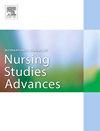Using Presence Circles to identify strategies to enhance nurse presence at discharge: a focus group study with nursing students
IF 3.1
Q1 NURSING
International Journal of Nursing Studies Advances
Pub Date : 2025-05-03
DOI:10.1016/j.ijnsa.2025.100338
引用次数: 0
Abstract
Background
Nurse communication of patient needs at discharge is critical to ongoing care, but system-level demands often prohibit comprehensive discharge conversations. Caregivers of discharged patients frequently report feeling underprepared to meet patient needs. Meaningful interpersonal encounters, or presence, are known to enhance clinical interactions amidst system-level demands, which could help improve caregiver preparedness and patient care.
Purpose
To explore and synthesize examples of nurse presence during discharge conversations through Presence Circles (structured focus groups) to provide recommendations for enhancing high-quality information at discharge.
Methods
In a secondary analysis of data from a larger study based on the Nurse Presence Framework, nursing students (N = 14) from a Northern California school were asked to participate in two Nurse Presence Circles. Audio recordings from 10 Presence Circles were transcribed and analysis was conducted according to the five practices of the Nurse Presence framework: Prepare with Intention, Listen Intently and Completely, Agree on What Matters Most, Connect with the Story, and Evolve System-Level Change.
Results
Within each of the five nurse presence practices, strategies and challenges were collapsed into broader themes that served as recommendations for enhancing the exchange of high-quality information at discharge.
Conclusions
Presence Circles offered a useful space to share strategies and identify system changes that could advance the exchange of high-quality information at discharge. We have provided a synthesis of recommendations for nurses, particularly those new to discharge conversations or early in their nursing career, demonstrating the need to engage nursing students about discharge conversations and introduce considerations related to health care systems and policy to better support the discharge conversation experience.
使用在场圈确定策略,以提高护士在场出院:焦点小组研究护理学生
出院时护士对患者需求的沟通对持续护理至关重要,但系统层面的需求往往禁止全面的出院对话。出院病人的护理人员经常报告说,他们对满足病人的需求准备不足。已知有意义的人际接触或存在可以增强系统级需求中的临床互动,这有助于改善护理人员的准备和患者护理。目的通过“在场圈”(结构化焦点小组)探讨和综合出院谈话中护士在场的例子,为提高出院时的高质量信息提供建议。方法对一项基于护士在场框架的大型研究的数据进行二次分析,要求来自北加州一所学校的护理专业学生(N = 14)参加两个护士在场圈。对来自10个在场圈的录音进行转录,并根据护士在场框架的五种实践进行分析:有意图地准备,专心而彻底地倾听,就最重要的事情达成一致,与故事联系,并进行系统级变革。结果在五个护士在场实践中,策略和挑战被分解为更广泛的主题,作为建议,以加强出院时高质量信息的交流。结论存在圈提供了一个共享策略和识别系统变化的有用空间,可以促进出院时高质量信息的交流。我们为护士提供了综合建议,特别是那些刚接触出院谈话或护理生涯早期的护士,展示了让护理学生参与出院谈话的必要性,并介绍了与卫生保健系统和政策相关的考虑因素,以更好地支持出院谈话经验。
本文章由计算机程序翻译,如有差异,请以英文原文为准。
求助全文
约1分钟内获得全文
求助全文
来源期刊

International Journal of Nursing Studies Advances
Nursing-General Nursing
CiteScore
5.80
自引率
0.00%
发文量
45
审稿时长
81 days
 求助内容:
求助内容: 应助结果提醒方式:
应助结果提醒方式:


